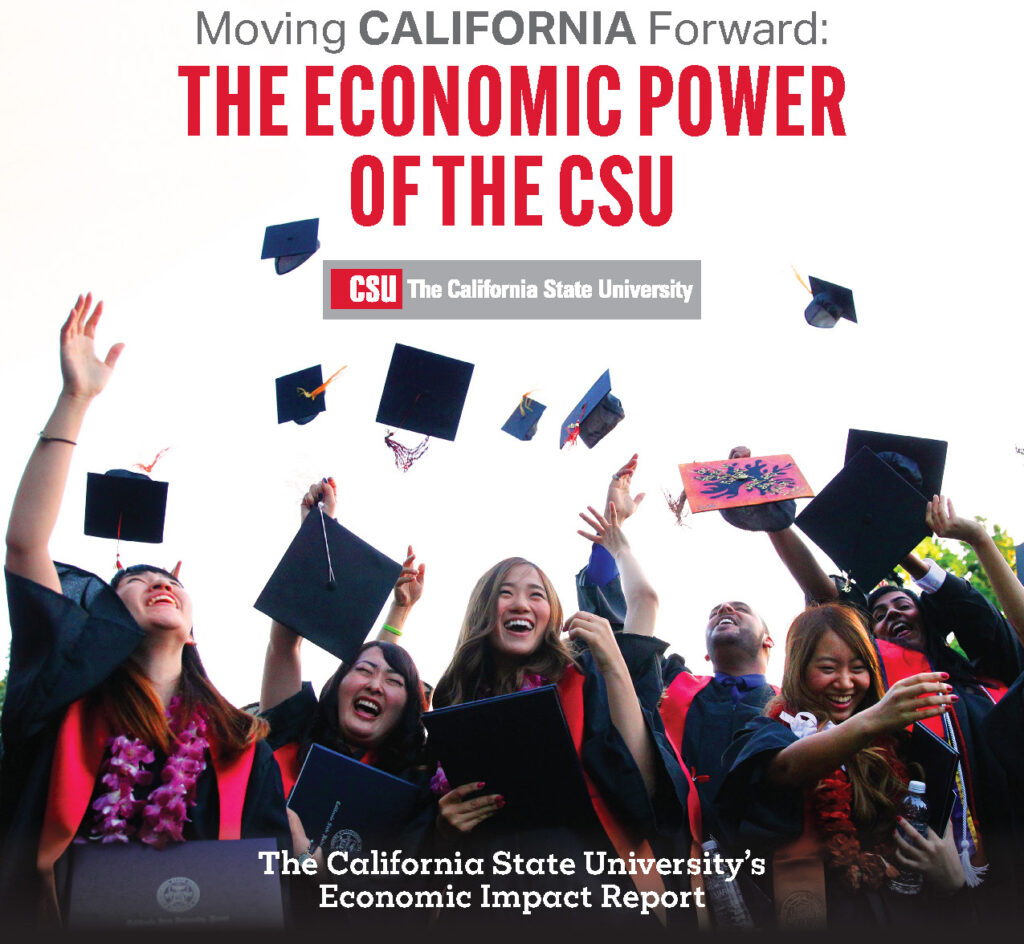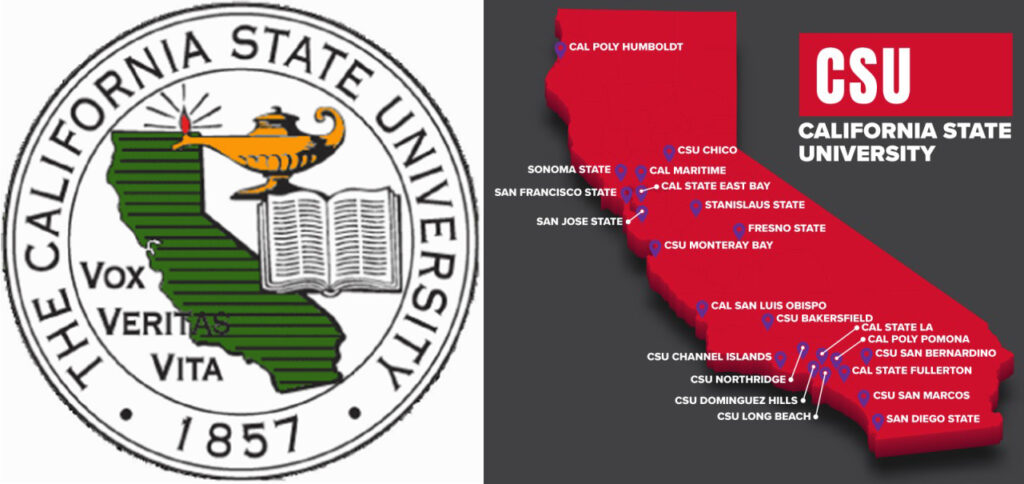Report: The CSU fuels nearly every aspect of California’s growing economy

From strengthening California’s workforce to contributing billions in statewide industry activity, the CSU’s massive economic impact is undeniable
By Jason Maymon, Senior Director & Amy Bentley-Smith, Director of Strategic Communications, CSU Media Relations & Public Affairs
On Tuesday, November 18, 2025, the California State University (CSU) released its 2025 economic impact report, underscoring the system’s broad contributions to fueling nearly every aspect of California’s economy
The report, Moving California Forward: The Economic Power of the CSU, details the role the CSU plays in strengthening the state’s key industries and preparing a skilled workforce essential to driving economic vitality. The report finds that in 2023–24 alone, CSU-related spending contributed more than $20 billion directly to California’s economy, generating $31.6 billion in statewide industry activity, supporting 210,800 jobs, and producing $2.3 billion in state and local tax revenue.
“This comprehensive report clearly demonstrates that resources entrusted to the CSU should not be considered an expenditure, but rather an investment – and an investment with a powerful and tangible return,” said CSU Chancellor Mildred García. “Importantly, the report measures not only dollars, jobs and industry activity, but also the CSU’s impact on our students’ lives and families, our contributions as a research powerhouse, and the countless benefits our universities deliver to our workforce, to communities across California, and to our nation.”

“Education opens doors — and there is no greater or more prestigious educational system than California’s public universities,” said Governor Gavin Newsom. “These schools are a lifeline for first-generation and working-class students and channel vital talent straight into our workforce. From classrooms to clinics, fields to film sets, CSU graduates power the services, industries, and innovation that make California dominate and thrive.”
“Across California, the CSU is moving California and the state’s workforce forward,” said Stewart Knox, secretary of the California Labor & Workforce Development Agency. “Nearly half of all bachelor’s degrees awarded in our state come from the CSU – preparing talent that meets California’s evolving workforce needs in every region and major industry.”

A Strong Return on Investment for California
For every dollar California invests in the CSU, the system generates $7.69 in statewide industry activity, which increases to $35.53 when factoring in alumni earnings, the report finds. CSU alumni, whose incremental earnings totaled $97.8 billion in 2024, create a ripple effect across industries and communities statewide.
Beyond the financial return, CSU’s role in educating more than half a million students delivers transformative social value by expanding access to higher education and accelerating upward mobility for the nearly 125,000 graduates who walk the commencement stage every year prepared to contribute and lead in their fields.

Powering California’s Workforce and Key Industries
As the producer of nearly half of California’s bachelor’s degrees, the CSU is providing the diverse, educated and skilled professionals required to meet workforce needs in the state’s top in-demand industries. Specifically, within the education and health services and professional and business services sectors, which together account for more than 1 million projected job openings by 2033, the CSU is producing over half of related bachelor’s degrees. CSU’s engineering and construction program also provides more than half of the state’s general engineering graduates, which supports infrastructure growth.
In the 2023-24 academic year, CSU campuses conferred:
- 29,000 degrees in health care (representing 46% of such degrees awarded in the state)
- 23,000 degrees in business and professional services (48%)
- 14,000 degrees in humanities and social sciences (56%)
The CSU also produces:
- 78% of the state’s agriculture graduates
- 46% of graduates in public policy and criminal justice
- 49% of graduates in media, culture and design
- 37% of new multiple subject credentialed teachers

Regional Impact: Strengthening Communities Across California
Each of the CSU’s 22 universities serve as anchor institutions, fueling job creation, innovation, and opportunity in their local community. The Economic Impact Report highlights significant regional benefits:
- Bay Area: $4.8 billion in industry activity and 31,000 jobs supported.
- Central Coast: $3 billion in industry activity and 31,500 jobs supported.
- Inland Empire: $1 billion in industry activity and 9,218 jobs supported.
- Los Angeles: $10 billion in industry activity and 74,900 jobs supported
- North Coast: $718 million in industry activity and 6,598 jobs supported.
- Sacramento Valley: $2.8 billion in industry activity and 24,613 jobs supported.
- San Diego: $3.9 billion in industry activity and 32,760 jobs supported.
- San Joaquin Valley: $2.6 billion in industry activity and 25,300 jobs supported.
These impacts demonstrate how the CSU powers California’s regional economies, ensuring that every corner of the state benefits from higher education, innovation, and workforce development.
For more information, view CSU’s 2025 Economic Impact Report at calstate.edu/impact.

Bay Area Regional Impact
CSU spending through campus operations, capital investment and student spending on and off campus stimulate the economy of the Bay Area region. As detailed in Appendix B of the report, the direct spending for each campus is estimated using CSU financial data, enrollment figures, average student budget estimates and an analysis of California-based alumni earnings over time.
CSUs in the Bay Area had a direct spend of over $3.6 billion during the 2023-24 academic year, comprising the following four categories:
- $1.7 billion on operational expenditures
- $279.6 million on capital expenditures (four-year average)
- $206.2 million on auxiliary expenditures
- $1.4 billion on student expenditures
Many CSU alumni from campuses in the Bay Area region remain in California, contributing to the local economy. In 2024, they earned $19.5 billion in incremental earnings due to their CSU degree. That money, when spent in the local economy, sparked secondary impacts.

During the 2023-24 academic year, CSUs in the Bay Area region generated a substantial economic impact across the region, supporting over 31,000 jobs and contributing $2.2 billion in labor income. Campus operational activities were the largest driver, accounting for more than 20,000 jobs and $1.4 billion in wages. Student spending and auxiliary services supported more than 8,000 jobs and injected nearly $1.7 billion into industry activity. Capital expenditures, while smaller in scale, supported 2,300 jobs and over $230 million in wages. Altogether, these activities culminated in $4.8 billion in industry activity and $321 million in tax revenues, underscoring the campuses’ vital role in regional economic vitality and public finance. Table 3 provides a further breakdown of results.
About the California State University
The California State University is the nation’s largest four-year public university system, providing transformational opportunities for upward mobility to more than 470,000 students from all socioeconomic backgrounds. More than half of CSU students are from traditionally underrepresented backgrounds, and more than one-quarter of undergraduates are first-generation college students. Because the CSU’s 22 universities* provide a high-quality education at an incredible value, they are rated among the best in the nation for promoting social mobility in national college rankings from U.S. News & World Report, the Wall Street Journal and Washington Monthly. The CSU powers California and the nation, sending nearly 125,000 career-ready graduates into the workforce each year. In fact, one in every 20 Americans holding a college degree earned it at the CSU. Connect with and learn more about the CSU in the CSU newsroom.
* Transition to 22 universities in progress (Cal Poly SLO and Cal Maritime integrating). The integration process is anticipated to be complete by fall 2026.
the attachments to this post:

CSU Bay Area Region Economic Impact

Total Impact of CSU on State by Region Table

Impact of CSU on Bay Area Region

Econ Contrib of CSU to CA Economy Table

CSU Economic-Impact-Report-2025 Cover



























